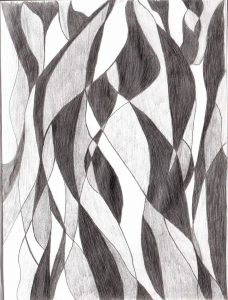
This sketch is a reflection of my state of mind during the dramatic experience of breaking my leg. Once I had recovered and could walk, not relying on a wheelchair or crutches, and once I could go back to school I decided to create this sketch. For 2 years I had been drawing in a sketchbook and I decided to use drawing as a medium because of Sigmund Freud’s theory called “free association.” Free association is when a person freely, without hindrance, shares there deep seeded feelings and unconscious thoughts (Schacter, 2014). This can be done through speech or it can be done through drawing, I opted for drawing because, for one, it does not require another person and because a sketch allows me to interpret what my feelings are. When I draw I have no plan for the drawing, I just move my pencil freely the way you are supposed to under free association. Furthermore, When I have completed the sketch I carefully look at it and I always find myself in it; I find my hidden feelings and unconscious thoughts represented in the sketch. Most of the time I do not know my feelings and my sketches are a way to see them, but sometimes I do know my feelings and use drawing as a medium to release it. Therefore, sketching and drawing for me is like the way people let their feelings out by telling another about it, like a friend or therapist.
However, this time was different to my usually sketches because I did it in a different way. I would usually draw for every incident that I wanted to let out, and in this case it would have been the feeling of being in a wheelchair, needing help to reach the bathroom, having to brush my teeth into a pot, and especially how, suddenly everyone around me thought I could not do anything. If I were to reach for a glass of water, someone would grab it and hand it to me instead, although I was fully capable of reaching it myself. Also, for the time I was in a wheelchair I had to maneuver through some difficult turns and narrow passages, and when I faced these turns, people would just grab the back of my wheelchair and guide me through. I would usually have separate sketches for each, however the pain of my leg was not allowing me to, so instead I did a cumulative sketch once I was recovered.
This sketch represents how I felt during my recovery and I have interpreted its meaning to be that I felt so constrained and restricted by my wheelchair, my leg, the physical pain, and by the people around me. If you look at the middle of the sketch, you can see a bird. That bird represents me and all that surrounds me is the constraints that were put on me. I felt enclosed, making me feel like a bird in a cage. This relates to when I was a child, and how my father would call me “bird” with love, but then my brother took it up and used it to tease me. This nickname “bird” brings irony to my sketch because I always hated being called a “bird” or having any connection to one, but after I broke my leg it was all I wanted to be. I wanted to be able to fly, to walk, to have no pain, to have the ability to do simple things, like brush my teeth standing up and going to the bathroom by myself. Instead the people who were over accommodating me, placed me in a cage. If you look at the sketch again you can see there is more than one bird. I am the bird in the middle and all the birds surrounding me, the people over accommodating me, are the makeshift cage; blocking my path by enclosing me with their bodies.
Therefore, this sketch represents my experience of breaking my leg as being a bird in a cage.
Works Cited
Schacter, D. L., Gilbert, D. L., Wegner, D. M., Nock, M. K., & Johnsrude, I. (2014). Psychology: Third Canadian Edition. New York, NY: Worth Publisher.